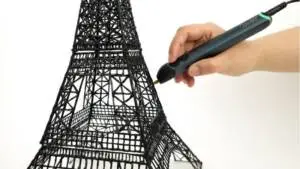If you’re someone who loves creativity and enjoys experimenting with various artistic mediums, then the world of 3D pens is sure to captivate your imagination. These innovative tools have taken artistic expression to a whole new level, allowing you to literally draw your creations in three dimensions. In this article, we’ll delve into the fascinating realm of 3D pens, exploring their features, applications, tips for usage, and more. By the end of this article, you’ll be well-equipped with the knowledge you need to dive into the world of 3D pen artistry.
In a world where traditional art forms are constantly evolving, 3D pens have emerged as a revolutionary tool for artists, hobbyists, and educators alike. These pens, resembling a bulkier version of their 2D counterparts, allow users to create physical objects by extruding heated plastic filament.

How Do 3D Pens Work?
3D pens operate on a simple yet ingenious mechanism. Inside the pen, plastic filament is fed through a heating element, which melts the plastic. The user then controls the flow of the molten plastic through the pen’s nozzle by pressing a button. As the plastic cools down rapidly, it solidifies, enabling users to build intricate structures layer by layer.
Choosing the Right 3D Pen
When venturing into the world of 3D pen artistry, it’s crucial to choose the right pen for your needs. Consider factors like filament compatibility, temperature control, speed settings, and ease of use. Higher-end models often offer more features and precise controls, while budget-friendly options are great for beginners.
Setting Up Your 3D Pen
Before you embark on your artistic journey, it’s important to set up your 3D pen correctly. Plug it in, insert the filament, and allow the pen to heat up. Different filaments require different temperatures, so consult the user manual for guidance.
Basic Techniques for 3D Pen Art
Begin with the basics: drawing simple shapes and lines in the air. As you get comfortable, try layering these shapes to build more complex structures. Experiment with speed settings and learn how to control the flow of the filament for varying line thicknesses.
Taking it Up a Notch
Once you’ve mastered the fundamentals, challenge yourself with intermediate projects. Create a miniature Eiffel Tower, a scaled-down cityscape, or even a personalized keychain. This is where your creativity truly starts to shine.
Advanced 3D Pen Artistry
In the advanced stage, you can push the boundaries of what’s possible with a 3D pen. Craft intricate jewelry, detailed sculptures, or intricate decorative items. This level of artistry requires patience and practice, but the results are immensely rewarding.
Combining 3D Printing and Pen Art
Some artists have taken to combining traditional 3D printing with 3D pen art to achieve stunning hybrid creations. 3D printed structures provide a sturdy base, while the pen adds intricate details and personalization.
3D Pens in Education
Educators are harnessing the power of 3D pens to make learning more engaging. Students can visualize complex concepts in three dimensions, turning abstract ideas into tangible objects. This hands-on approach fosters creativity and deepens understanding.
The Future of 3D Pen Technology
As technology continues to advance, so too will 3D pen capabilities. We can expect more compact and ergonomic designs, enhanced features for greater precision, and the integration of smart technologies that streamline the creative process.
Tips for Maintaining Your 3D Pen
Proper maintenance ensures the longevity of your 3D pen. Regularly clean the nozzle, prevent filament jams, and store your pen in a cool, dry place.
Common Challenges
3D pen novices often face challenges such as filament breakage, inconsistent flow, and wobbly structures. These hurdles are normal, and practice is the key to overcoming them.
Inspiration from Expert 3D Pen Artists
The work of expert 3D pen artists can serve as a wellspring of inspiration. Study their techniques, explore their creations, and don’t hesitate to incorporate their ideas into your own unique projects.
Using 3D Pens Responsibly
While 3D pens offer endless creative possibilities, they also involve working with heated elements. Prioritize safety by wearing heat-resistant gloves, working in a well-ventilated area, and keeping the pen away from children and flammable materials.
FAQs
Can I use different types of filaments in my 3D pen?
Yes, most 3D pens are compatible with a variety of filament materials, including PLA, ABS, and more.
Is 3D pen art suitable for children?
While 3D pen art can be a fantastic creative outlet for kids, adult supervision is recommended due to the heated components.
Are there any advanced 3D pens with temperature controls?
Absolutely, many advanced 3D pens allow you to adjust the temperature settings to accommodate different filament types.
Can I sell the creations I make with a 3D pen?
Of course! Many artists sell their 3D pen creations on various platforms, showcasing the unique appeal of handmade 3D art.
What’s the main difference between 3D printing and 3D pen art?
While both involve creating three-dimensional objects, 3D printing builds layer by layer from a digital model, while 3D pen art allows for freehand creation.
Conclusion
In the realm of artistry, 3D pens stand as a bridge between imagination and reality. With dedication, practice, and a touch of patience, you can transform mere plastic filament into intricate, tangible creations. So, go ahead and unleash your imagination – the world of 3D pen art awaits.
